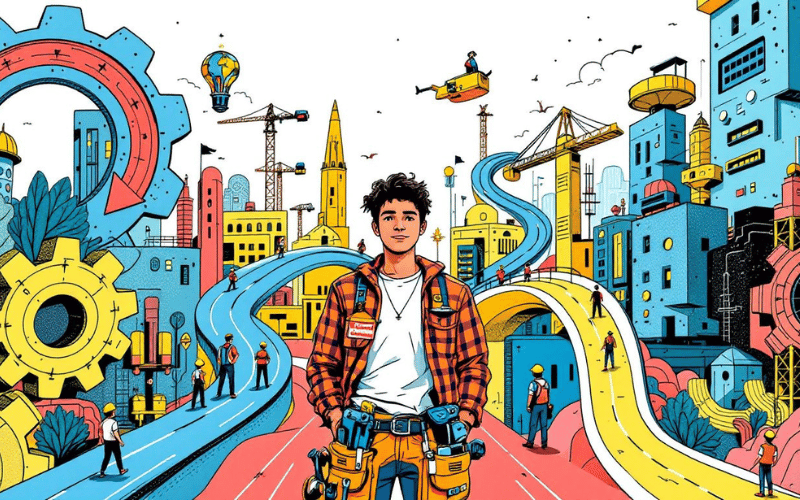
Work-based learning in high school blends classroom education with hands-on work experiences. It equips students with vital skills and insights into various careers. In this guide, we’ll discuss different programs related to what is work based learning in high school, their benefits, and how they integrate with career and technical education. Collaboration with postsecondary institutions is also crucial in providing students with essential skills for the workforce, as defined in the Perkins V legislation.
Quick Facts on Work Based Learning In High Schools
- 79% of high school students express interest in participating in WBL experiences.
- Only 34% of high school students are aware of WBL opportunities for their age group.
- A mere 2% of U.S. high school students complete internships.
- The traditional school day structure often inhibits the expansion of WBL opportunities.
Understanding Work Based Learning in High School
Work-based learning (WBL) is a dynamic educational approach that integrates classroom instruction with real-world work experiences. The primary goal of WBL for high school students is to equip them with the skills and knowledge necessary for independence and fulfillment in adulthood. Through WBL programs, students gain hands-on experience and develop crucial employability skills, such as communication and teamwork, vital for their future careers.
WBL enhances career awareness by exposing students to various industries and professions, helping them make informed decisions about their academic courses and career paths. This exposure enables students to explore various career options and develop a clearer understanding of their interests and strengths. WBL initiatives support career development and career exploration by offering practical experiences that complement classroom learning.
Providing comprehensive resources related to WBL, such as tool kits and resource centers, assists program administrators and educators in effectively integrating work-based learning into educational programs.
A key component of WBL programs is the classroom instruction that connects theoretical knowledge with real-world application. This integration ensures that students can see the relevance of their academic studies in a work setting, making learning more engaging and meaningful. Students can also earn academic credit through registered WBL experiences, further motivating their participation.
Types of Work Based Learning Programs

Work-based learning programs come in various forms, each offering unique opportunities for students to gain valuable work experience. These programs connect students with employers, providing insights into different careers and enhancing their understanding of the professional world. Let’s explore some of the most common types of WBL programs.
Internships
Internships rank among the most popular forms of WBL. They can be paid or unpaid, offering students flexibility while gaining experience. Typically, students in grades 9-12 engage in internships, starting their career development early. Internships offer hands-on experience in real work environments, helping students develop practical skills and build professional networks.
Apprenticeships
Apprenticeships involve learning a skilled trade through on-the-job training. These structured programs are designed in collaboration with employers and often include a combination of classroom instruction and hands-on training. Apprenticeships are ideal for students interested in pursuing careers in technical fields, as they provide in-depth knowledge and skills in a specific trade.
Job Shadowing
Job shadowing allows students to observe professionals in their work environment, providing valuable WBL experience. This type of program provides insights into industry practices and expectations, helping students understand the day-to-day responsibilities of different careers. Job shadowing is particularly beneficial for students who are still exploring their career options, as it offers a glimpse into various professions without long-term commitment.
Each of these WBL programs offers unique benefits, providing students with the flexibility and structured experiences needed to explore their career interests and develop essential skills. By participating in these programs, students can gain a deeper understanding of the professional world and make more informed decisions about their future careers.
Benefits of Work Based Learning for Students

The benefits of work-based learning for students are numerous and far-reaching. Participation in WBL programs helps students make informed choices about their academic courses and future career paths. By engaging in real-world work experiences, students gain critical hands-on experience that is particularly valuable in high-stakes environments such as healthcare.
One of the most significant advantages of WBL is the development of essential employability skills, such as communication, teamwork, and problem-solving. These soft skills are crucial for success in any career and are often emphasized in WBL programs. Additionally, students have the opportunity to earn income through paid internships, allowing them to gain experience while also supporting themselves financially.
Mentorship plays a critical role in successful WBL programs. Research indicates that mentorship from community professionals enhances student engagement and skill development. Mentors offer guidance, support, and valuable industry insights, bridging the gap between theoretical knowledge and practical application. Networking opportunities with industry professionals also boost students’ career prospects.
Adapting WBL experiences to classroom settings reduces logistical challenges and expands career opportunities for students. This adaptability ensures that all students, including those with disabilities, can benefit from WBL programs. Establishing clear learning objectives aligned with classroom curricula allows educators to create effective WBL programs with meaningful and relevant experiences for students.
Overall, WBL offers a comprehensive approach to career preparation, equipping students with a broad array of skills and knowledge needed for success in the workforce.
How Work Based Learning Supports Career and Technical Education (CTE)

Work-based learning supports career and technical education (CTE program) by providing students with practical experience and academic credit. The synergy between WBL and CTE enhances the connection between academic knowledge and its practical application in real-world contexts. This integration ensures that students can see the relevance of their academic studies in their chosen careers, making learning more engaging and meaningful.
A successful WBL program combines hands-on practical experiences with rigorous academic requirements. These programs are customized to align with local economic needs and workforce demands, ensuring that students are prepared for the job market in their communities. Collaboration with local employers is essential to enhance learning outcomes and provide students with relevant and up-to-date industry knowledge.
Mentorship opportunities are critical in supporting students during their WBL experiences. Mentors provide guidance, support, and valuable industry insights, helping students bridge the gap between theoretical knowledge and practical application. By integrating WBL into CTE programs, educators can create a comprehensive approach to career preparation that equips students with the skills and knowledge needed for success in the workforce.
Role of Educators and Community Professionals in Work Based Learning
Collaboration between educators and community professionals is vital for the success of work-based learning (WBL) programs. Educators should establish partnerships with local industry professionals to create meaningful WBL experiences for students. These partnerships ensure that students are exposed to relevant and up-to-date industry knowledge, enhancing their career preparation.
Ongoing collaboration with well-defined roles for each party is essential for WBL activities. Community, regional, and statewide partners should also participate in providing WBL experiences, ensuring a broad range of opportunities for students. Involving stakeholders such as school administrators and local businesses early in the planning process can enhance the efficiency and effectiveness of WBL initiatives.
Collecting feedback from students and employers post-activity is important for the continuous improvement of the WBL program. This feedback helps educators identify areas for improvement and make necessary adjustments to ensure that the program meets the needs of all participants. Working together, educators and community professionals can create a robust WBL program that offers students valuable real-world experiences.
Steps to Implement a Successful Work Based Learning Program
Implementing a successful work-based learning program involves a sequence of learning activities that advance from career awareness to hands-on job preparation. Educators should begin by introducing students to various careers and industries, helping them understand the range of opportunities available. As students progress, more hands-on experiences such as internships and apprenticeships become available.
Quality WBL experiences include defined learning objectives directly connected to school curricula. This connection ensures that students can see the relevance of their academic studies in a work setting, making learning more engaging and meaningful. Collaboration with specialized organizations allows educators to implement effective WBL programs without overburdening their resources.
A work-based learning toolkit outlines essential elements for establishing effective programs and linking classroom learning with workplace experiences. This toolkit provides educators with the guidance and resources needed to create successful WBL programs. Following these steps, educators can create a comprehensive WBL program offering students valuable real-world experiences and preparing them for future careers.
The Future of Work Based Learning In High School

In summary, work-based learning (WBL) in high schools is a transformative educational approach that effectively bridges the gap between classroom learning and real-world work experiences. By integrating hands-on experiences such as internships, apprenticeships, and job shadowing, WBL equips students with essential employability skills and insights into various career paths. These programs not only enhance career awareness but also support career and technical education (CTE), ensuring students are well-prepared for future workforce demands.
Educators and community professionals play a pivotal role in the success of WBL programs by fostering partnerships with local industries and providing mentorship opportunities. These collaborations ensure that students receive relevant and practical industry knowledge, enhancing their career preparation and professional development. The continuous feedback loop between students, educators, and employers further refines these programs, making them more effective and inclusive.
With recent legislative actions and public-private partnerships, the future of WBL in high schools is promising. These initiatives aim to expand access and dismantle barriers, particularly for underrepresented student groups, ensuring equitable opportunities for all. As WBL programs continue to evolve and receive dedicated support, they offer students a comprehensive platform to thrive in their future careers, making learning both engaging and meaningful.
Common Questions Around Work Based Learning In High Schools
What does work-based learning mean in high school?
Work-based learning in high school integrates classroom instruction with real-world work experiences, equipping students with practical skills and knowledge essential for their future careers. This method enhances both academic learning and workforce readiness.
What is an example of work-based learning?
Internships, apprenticeships, and job shadowing are common examples of work-based learning programs that provide students with valuable hands-on experience in their chosen fields. Each type offers distinct opportunities to enhance skills and professional development.
What is workplace learning in high school?
Workplace learning in high school provides students with practical, hands-on experiences that allow them to understand employer expectations and how to apply their academic and technical skills in real-world settings. This authentic engagement can significantly aid in their career exploration and preparation.
What grade do you have to be in to do work-based learning?
Typically, students in grades 9-12 engage in work-based learning programs, starting their career development early. These opportunities offer hands-on experience in real work environments, helping students develop practical skills and build professional networks.


